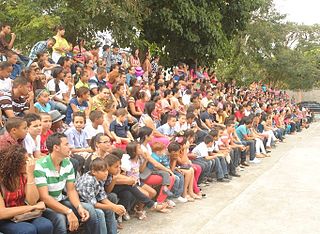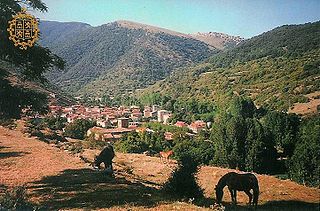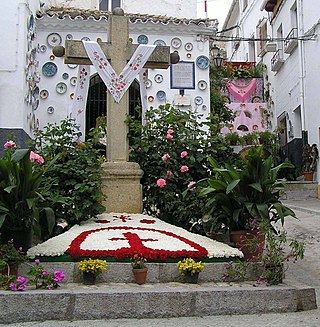Related Research Articles

Carnival is a Western Christian festive season that occurs before the liturgical season of Lent. The main events typically occur during February or early March, during the period historically known as Shrovetide. Carnival typically involves public celebrations, including events such as parades, public street parties and other entertainments, combining some elements of a circus. Elaborate costumes and masks allow people to set aside their everyday individuality and experience a heightened sense of social unity. Participants often indulge in excessive consumption of alcohol, meat, and other foods that will be forgone during upcoming Lent. Traditionally, butter, milk, and other animal products were not consumed "excessively", rather, their stock was fully consumed during Shrovetide as to reduce waste. This festival is known for being a time of great indulgence before Lent, with drinking, overeating, and various other activities of indulgence being performed. For example, pancakes, donuts, and other desserts are prepared and eaten for a final time. During Lent, lacticinia and animal products are eaten less, and individuals make a Lenten sacrifice, thus giving up a certain object or activity of desire.

The Day of the Dead is a holiday traditionally celebrated on November 1 and 2, though other days, such as October 31 or November 6, may be included depending on the locality. It is widely observed in Mexico, where it largely developed, and is also observed in other places, especially by people of Mexican heritage. Although related to the simultaneous Christian remembrances for Hallowtide, it has a much less solemn tone and is portrayed as a holiday of joyful celebration rather than mourning. The multi-day holiday involves family and friends gathering to pay respects and to remember friends and family members who have died. These celebrations can take a humorous tone, as celebrants remember funny events and anecdotes about the departed.

The festival of San Fermín is a week-long, historically rooted celebration held annually in the city of Pamplona, Navarre, in northern Spain. The celebrations start at noon on 6 July and continue until midnight on 14 July. A firework (Chupinazo) starts off the celebrations and the popular song Pobre de mí is sung at the end. The most famous event is the running of the bulls, which begins at 8 a.m. each day on 7–14 July, but the festival involves many other traditional and folkloric events. It is known locally as Sanfermines and is held in honour of Saint Fermin, the co-patron of Navarre.

Saint John's Eve, starting at sunset on 23 June, is the eve of the feast day of Saint John the Baptist. This is one of the very few feast days marking a saint's birth, rather than their death. The Gospel of Luke states that John was born six months before Jesus; therefore, the feast of John the Baptist was fixed on 24 June, six months before Christmas. In the Roman calendar, 24 June was the date of the summer solstice, and Saint John's Eve is closely associated with Midsummer festivities in Europe. Traditions are similar to those of May Day and include bonfires, feasting, processions, church services, and gathering wild plants.

The culture of the Dominican Republic is a diverse mixture of different influences from around the world. The Dominican people and their customs have origins consisting predominantly in a European cultural basis, with native Taíno and African influences.

A quinceañera is a celebration of a girl's 15th birthday. It has cultural roots in Mexico and is widely celebrated by girls throughout Latin America. The girl celebrating her 15th birthday is a quinceañera. In Spanish, primarily in Latin America, the term quinceañera is reserved solely for the honoree; in English, primarily in the United States, the term is used to refer to the celebrations and honors surrounding the occasion.
A patronal feast or patronal festival is a yearly celebration dedicated – in countries influenced by Christianity – to the 'heavenly advocate' or 'patron' of the location holding the festival, who is a saint or virgin. The day of this celebration is called patronal feast day, patronal day or patron day of said location.

Aloysia citrodora, lemon verbena, is a species of flowering plant in the verbena family Verbenaceae, native to South America. Other common names include lemon beebrush. It was brought to Europe by the Spanish and the Portuguese in the 17th century and cultivated for its oil.
The Bonfires of Saint John are a traditional and popular festival celebrated in the city of Alicante, Spain, from 19 to 24 June. The celebration ultimately stems from a tradition of bonfires for Saint John's Eve that can be found in many places, among them the Mediterranean coast of Spain, especially Catalonia and the Valencian Community; in Alicante, it's the official and most important festivity in the city. It was officially declared as a Fiesta of International Tourist Interest in 1983 and a Bien de Interés Cultural in 2014.
Género chico is a Spanish genre of short, light plays with music. It is a major branch of zarzuela, Spain's form of popular music theatre with dialogue, and differs from zarzuela grande and most other operatic forms both in its brevity and by being aimed at audiences of a wide social spectrum.
Verbena is a genus of plants in the family Verbenaceae

The Barranquilla's Carnival is one of Colombia's most important folkloric celebrations, and one of the biggest carnivals in the world. The carnival has traditions that date back to the 19th century. Four days before Lent, Barranquilla decks itself out to receive national and foreign tourists to join together with the city's inhabitants to enjoy four days of intense festivities. During the carnival, Barranquilla's normal activities are put aside as the city gets busy with street dances, musical and masquerade parades. The Carnival Of Barranquilla includes dances such as the Spanish paleo, African Congo, and indigenous mice y mica's. Many styles of Colombian music are also performed, most prominently cumbia, and instruments include drums and wind ensembles. The Carnival of Barranquilla was proclaimed a Cultural Masterpiece of the Nation by Colombia's National Congress in 2002. Also the UNESCO, in Paris on November 7, 2003, declared it one of the Masterpieces of the Oral and Intangible Heritage of Humanity, and it was during Olga Lucia Rodriquez Carnival Queen year.

Carlos Marín Menchero was a Spanish baritone and a member of the classical crossover group Il Divo, which has sold over 28 million records worldwide.

Pasodoble is a fast-paced Spanish military march used by infantry troops. Its speed allowed troops to give 120 steps per minute. This military march gave rise recently to a modern Spanish dance, a musical genre including both voice and instruments, and a genre of instrumental music often played during bullfight. Both the dance and the non martial compositions are also called pasodoble.

Gibraltarian cuisine is the result of a long relationship between the people of Spanish Andalusia and those of Great Britain, as well as the many foreigners who have made Gibraltar their home over the past three centuries. These influences include those of the culinary traditions of Malta, Genoa, and Portugal. This marriage of tastes has produced in Gibraltar an eclectic mix of Mediterranean and British cuisines.

Viniegra de Abajo is a municipality of La Rioja (Spain).

The Fiesta de las Cruces or Cruz de Mayo is a holiday celebrated on 3 May in many parts of Spain and Hispanic America.

Castañada, Magosta, Magosto or Magusto, is a traditional festival on the Iberian Peninsula. It is popular in Portugal, Galicia and some areas of northern Spain, such as Cantabria, Asturias, Catalonia, and the provinces of León, Zamora and Salamanca and Cáceres, but also in some parts of the Canary Islands. The festival is also celebrated in both sides of the French-Spanish border. It has also spread internationally as a 'chestnut party'. Etymological origins are unknown, but there are several theories for the Magosto name: Magnus Ustus or Magum Ustum.

La verbena de la Paloma —subtitled El boticario y las chulapas y celos mal reprimidos— is an 1894 zarzuela with a libretto by Ricardo de la Vega and music by Tomás Bretón. It premiered on 17 February 1894 in Teatro Apolo, Madrid. It was later adapted for the cinema in 1921 by José Buchs, in 1935 as Paloma Fair by Benito Perojo and in 1963 as The Fair of the Dove by José Luis Sáenz de Heredia.
Paloma Fair is a 1935 Spanish musical film directed by Benito Perojo and starring Miguel Ligero, Roberto Rey and Raquel Rodrigo. It is an adaptation of the 1894 Zarzuela La verbena de la Paloma and it is part of the tradition of Operetta films which was at its height during the 1930s. The film was made by Spain's largest studio of the era CIFESA, and was one of the most popular films made during the Second Spanish Republic.
References
- ↑ "The Entertainment in Spain". www.travelnet.co.il. Archived from the original on September 15, 2004.
- ↑ "Fiestas". www.hectorocio.com. Archived from the original on July 24, 2003.
- ↑ "Verbena". Elalmanaque.com. Retrieved 2014-04-28.
- ↑ "buy-music-cd.co.uk". Musicweb.uk.net. Retrieved 2014-04-28.
- ↑ "La verbena de la Paloma". IMDb .
- ↑ "Verbena de San Cayetano". Ingeb.org. Retrieved 2014-04-28.